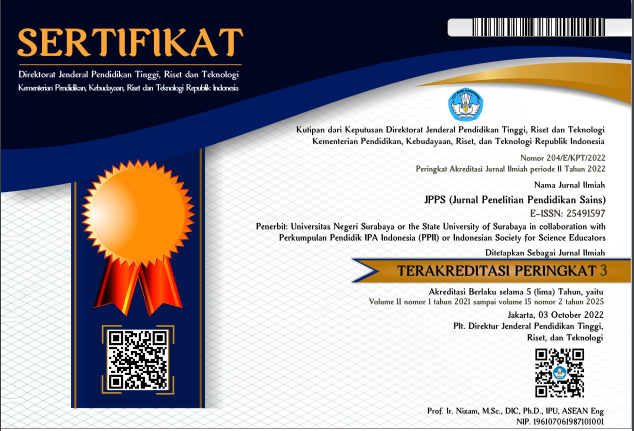STUDENT TEACHING MATERIALS AND SCIENCE LITERATURE IN SCIENCE LEARNING DURING THE COVID-19 PANDEMIC
DOI:
https://doi.org/10.26740/jpps.v11n1.p52-61Keywords:
COVID-19, Scientific literacy , Science learning , Teaching materialsAbstract
The research aims to analyze the teaching materials needed by the teacher and the level of students' scientific literacy in the science learning process in the COVID-19 pandemic era. The descriptive quantitative method was utilized in the present study. The subject of the survey is 35 science teachers in Bogor and 150 grade VIII students at one of the junior high schools in the Bogor district. The instruments used in this study were questionnaires and scientific literacy tests. The collected data were analyzed quantitatively by calculating the percentage acquisition of students' scientific literacy then categorized. The study results revealed that the teaching materials used were not proportional in containing aspects of scientific literacy; 50% of students have scientific literacy ability in the low category, 40% in the moderate category, and 10% in the high category. The questionnaire results indicate that the factors affecting students' scientific literacy are their interest in science, learning motivation, teacher strategies in learning, and the facilities.
Downloads
References
Ardianto, D., & Pursitasari, I. D. (2017). Do middle school science textbook enclose an entity of science literacy? Journal of Humanities and Social Studies, 1(1), 24-27. https://doi.org/10.33751/jhss.v1i1.369
Arikunto, S. (2016). Dasar - dasar evaluasi pendidikan edisi kedua. Jakarta: Bumi Aksara.
Asyhari, A., & Hartati, R. (2015). Profil peningkatan kemampuan literasi sains siswa melalui pembelajaran saintifik. Jurnal Ilmiah Pendidikan Fisika, 4(2), 179-191. https://doi.org/10.24042/jpifalbiruni.v4i2.91
Azhari, B,. & Fajri, I. (2021). Distance learning during the COVID-19 pandemic: School closure in Indonesia. International Journal of Mathematical Education in Science and Technology, February, 1-21. https://doi.org/10.1080/0020739X.2021.1875072
Fraenkel, J. R., Wallen, N. E., & Hyun, H. H. (2012). How to design and evaluate research in education. New York: McGraw-Hill.
Harlina, Ramlawati, & Rusli, M. A. (2020). Deskripsi kemampuan literasi sains peserta didik Kelas IX di SMPN 3 Makassar. Jurnal IPA Terpadu. 3(2), 96-107. https://doi.org/10.35580/ipaterpadu.v3i2.12320
Hendri, S., & Hasriani, M. (2019). Identifikasi literasi sains mahasiswa (Studi kasus mahasiswa STISIP Amal Ilmiah Yapis Wamena). Journal of Natural Science and Integration, 2(1), 95. https://dx.doi.org/10.24014/jnsi.v2i1.7117
Kermin, J., Ikpeze, C., & Kimaru, I. 2015. Perspective on science literacy: A comparative study of United States and Kenya. Educational Research International, 4(2), 25-34. https://core.ac.uk/download/pdf/48620001.pdf
Kurniasari, A., Pribowo, F. S. P., & Putra, D. A. (2020). Analisis efektivitas pelaksanaan Belajar Dari Rumah (BDR) selama pandemi Covid-19. Jurnal Review Pendidikan Dasar. 6(3), 246-253. https://doi.org/10.26740/jrpd.v6n3.p246-253
Martin, M. O., Mullis, I. V. S., Foy, P., & Hooper, M. (2016). TIMSS 2015 international results in science. New York: TIMSS & PIRLS International Study Center.
The National Academy of Science. (2016). National science education standards. New York: National Academy Press.
Nelson, E., Scharmann, L. C., Beard, D., & Flammer, L. I. (2019). The nature of science as a foundation for fostering a better understanding of evolution. Evolution: Education and Outreach, 12(6), 1-6. https://doi.org/10.1186/s12052-019-0100-7
OECD. (2016). PISA 2015 Results in focus. New York: OECD Publishing.
OECD. (2019). PISA 2018 results what students know and can do volume I. New York: OECD Publishing.
Okada, A. (2013). Scientific literacy in the digital age: Tools, environments and resources for co-inquiry. European Scientific Journal, 9(10), 263-274.
Pan, X. B. (2020). Application of personal-oriented digital technology in preventing transmission of COVID-19, China. Irish Journal of Medical Science, 189(4), 1145-1146. https://doi.org/10.1007/s11845-020-02215-5
Pursitasari, I. D., Suhardi, E., Ardianto, D., Arif, A. (2019). Pengembangan bahan ajar bermuatan konteks kelautan untuk meningkatkan literasi sains siswa. Jurnal IPA dan Pembelajaran IPA, 3(2), 88-105. https://doi.org/10.24815/jipi.v3i2.14847
Rubini, B., Pursitasari, I. D., & Ardianto, D. (2017). Model pembinaan guru IPA berbasis literasi sains. Bogor: Sekolah Pascasarjana Universitas Pakuan.
Rusilowati, A., Kurniawati, L., Nugroho, S. E., & Widiyatmoko, A. (2016). Developing an instrument of scientific literacy assessment on the cycle theme. International Journal of Environmental & Science Education, 11(12), 5718-5727.
UNESCO. (2020). COVID-19 Educational disruption and response. https://en.unesco.org/news/covid-19-educational-disruption-and-response
Wulandari, N., & Sholihin, H. (2016). Analisis kemampuan literasi sains pada aspek pengetahuan dan kompetensi sains siswa SMP pada materi kalor. EDUSAINS, 8(1), 66-73. https://doi.org/10.15408/es.v8i1.1762
Yuliati, Y. (2017). Literasi sains dalam pembelajaran IPA. Jurnal Cakrawala Pendas, 3(2), 21-28. https://doi.org/10.31949/jcp.v3i2.592
Downloads
Published
How to Cite
Issue
Section
License
Copyright (c) 2021 JPPS (Jurnal Penelitian Pendidikan Sains)

This work is licensed under a Creative Commons Attribution-NonCommercial 4.0 International License.
 Abstract views: 385
,
Abstract views: 385
, PDF Downloads: 316
PDF Downloads: 316












